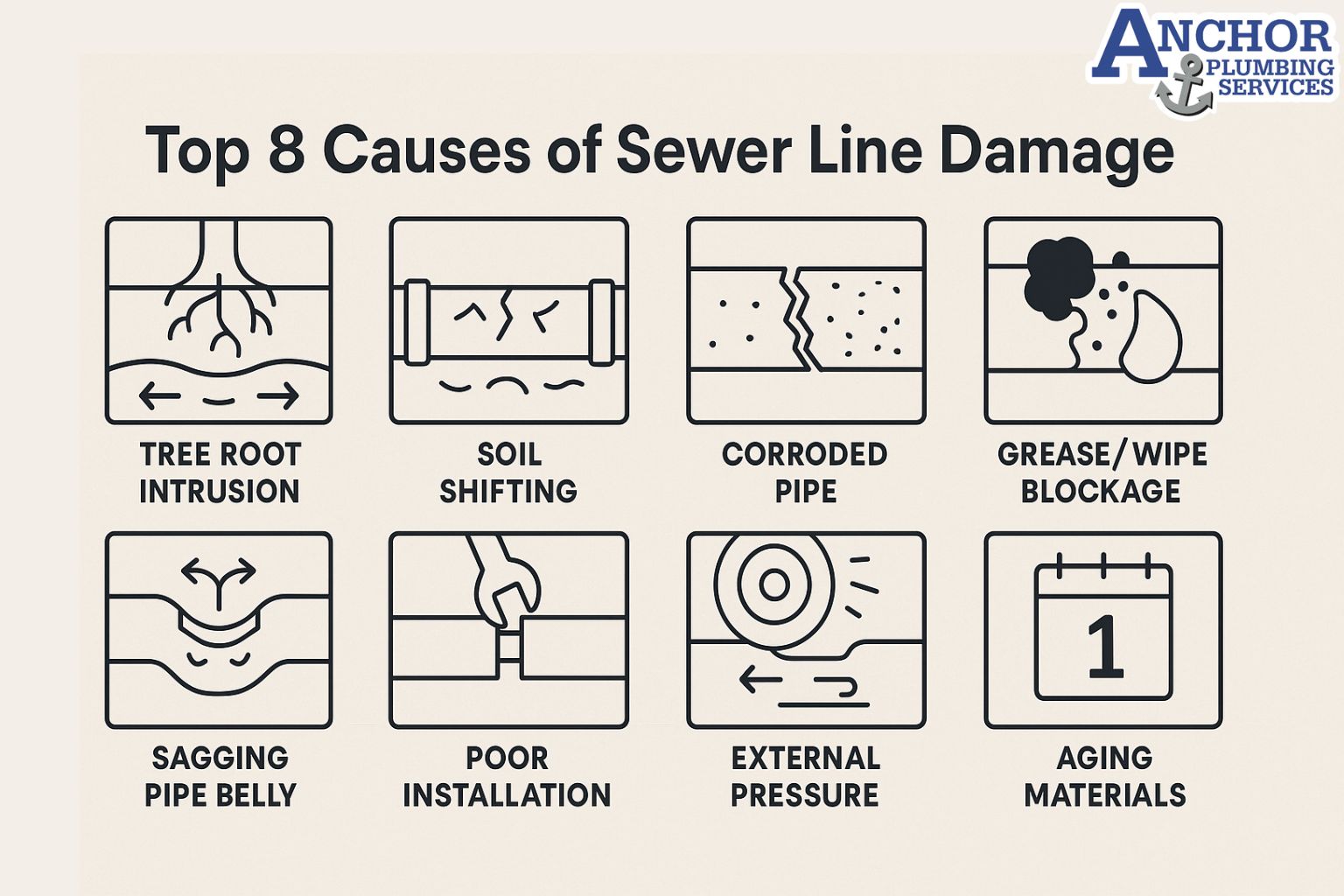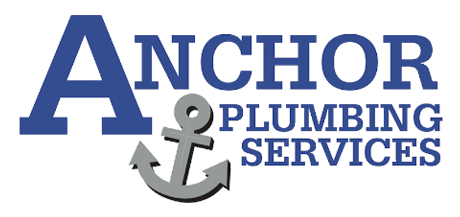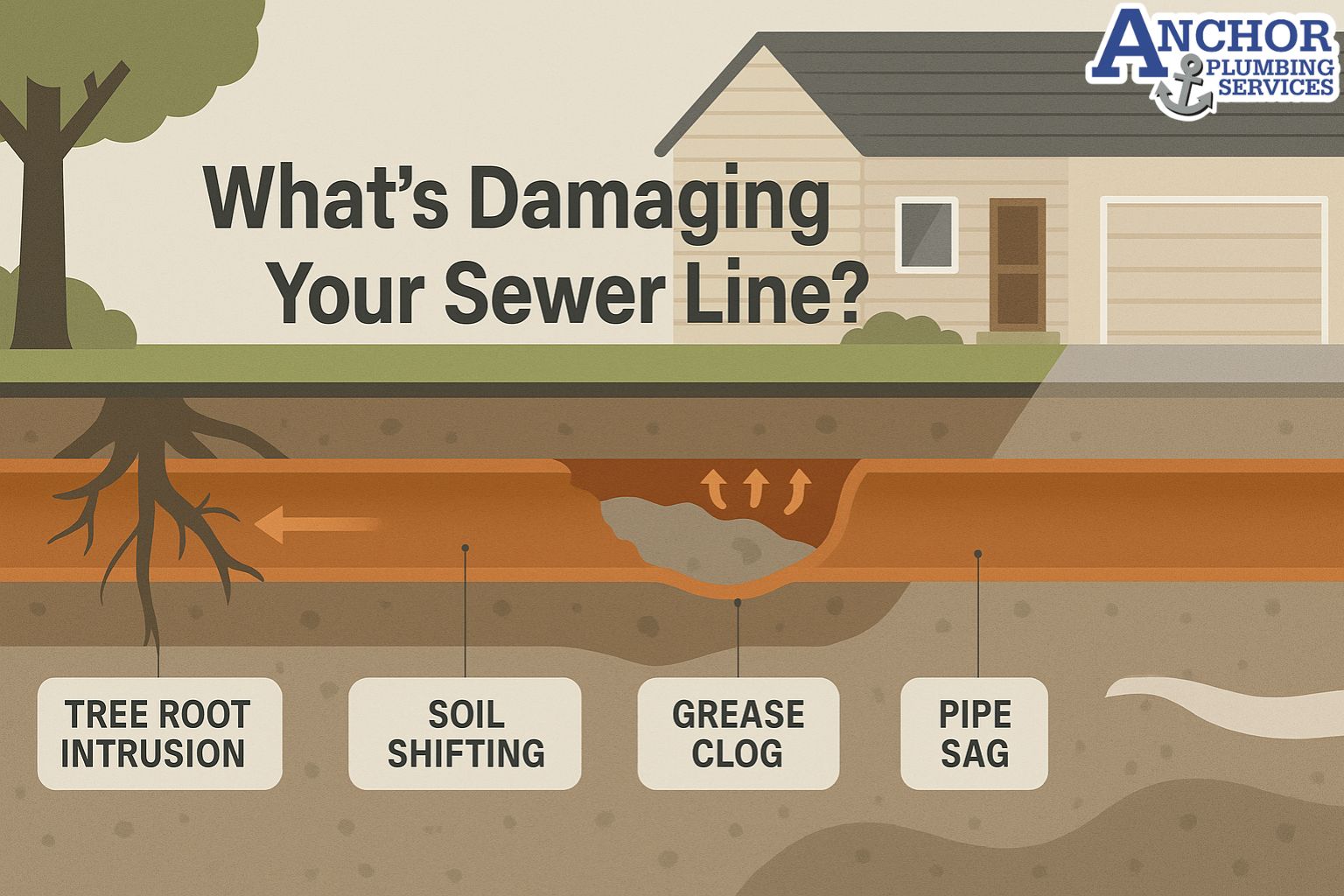Sewer line damage is a growing issue in residential plumbing systems. It occurs when underground pipes that carry wastewater from the home to the municipal sewer system fail due to environmental conditions, structural defects, or poor usage practices. These failures often remain hidden until surface symptoms emerge—such as slow drains, recurring backups, or visible sinkholes in the yard.
Each problem originates from different factors: soil movement, pipe material corrosion, tree root intrusion, and household waste buildup. These damage types develop over time, leading to cracks, blockages, or even full pipe collapse beneath foundations or lawns.
This article explains seven of the most common causes of sewer line failure, helping homeowners identify risk factors early and reduce repair costs.
What is Sewer Line Damage in Residential Plumbing?
Sewer line damage refers to the physical breakdown or functional failure of the underground pipe—typically the private lateral—that carries wastewater from your home to the municipal sewer system. Most residential lines are buried beneath the yard or foundation and remain unseen until a problem disrupts flow.
Common symptoms of sewer line damage include:
- Slow-draining sinks and tubs
- Gurgling sounds from toilets or drains
- Sewage odors around fixtures or in the yard
- Water pooling near foundation or lawn depressions
Damage can result from cracks, joint separation, pipe collapse, or tree root invasion. Older systems using clay or cast-iron pipes are more vulnerable to failure due to corrosion or soil pressure.
“When sewer lines crack or collapse, wastewater cannot exit properly. This results in sewer backups and surface water seepage near the failure point.”
In most cases, identifying sewer damage requires a video camera inspection, especially if symptoms appear in multiple drains simultaneously. While municipal lines handle city-wide flow, the private lateral is the homeowner’s responsibility from the house to the main connection.

1. Tree Root Intrusion
Tree roots are a leading cause of residential sewer line damage. They grow toward underground pipes in search of moisture and nutrients, especially when small leaks or condensation are present. Over time, roots enter tiny gaps in pipe joints or cracks in clay and cast iron sewer lines.
As the root diameter expands, it exerts pressure on the pipe wall. This leads to joint separation, increased leakage, and partial or complete blockages in the sewer lateral.
Older pipes with unsealed joints—typically pre-1970 clay or cast iron—are most vulnerable. Once inside the pipe, roots continue growing and trap solid waste, worsening the clog.
“Root intrusion causes both internal blockage and external soil displacement, resulting in sewer line and landscape damage.”
In severe cases, root clusters fracture the pipe entirely or force wastewater to surface near foundations or yards.
2. Soil Shifting and Ground Movement
Shifting soil is a structural cause of underground sewer damage, especially in regions like San Antonio, where clay-heavy soils expand during wet seasons and contract in dry ones. These seasonal changes cause the ground to push and pull against sewer lines buried beneath yards or foundations.
As soil expansion rates vary by depth and moisture retention, pipes without proper bedding or slope support may misalign. This often results in cracked joints, reverse slope (back-pitch), or total collapse of segments beneath the foundation slab.
“Seasonal soil movement alters the slope of a sewer line, reducing flow efficiency and increasing stress at pipe joints.”
Newer homes may include flexible couplings or improved bedding materials, but older pipes with rigid connections face higher risk. Structural misalignment from ground movement can also lead to visible foundation damage over time.
3. Aging or Corroded Pipe Materials
Sewer lines degrade over time depending on their material type and exposure to internal and external conditions. Most homes built before the 1980s used cast iron or clay pipes, both of which deteriorate structurally over decades.
Cast iron corrodes from the inside due to hydrogen sulfide gas, a byproduct of sewage. This corrosion eats away the pipe wall, forming rough surfaces and eventual holes. Clay pipes, though resistant to rot, are brittle and prone to cracking under pressure or joint separation.
“Corroded or aged sewer pipes lose structural integrity and are more likely to collapse or leak under normal flow pressure.”
In contrast, PVC and HDPE pipes offer improved corrosion resistance and flexibility, but even these can warp or separate when installed improperly.
Pipe lifespan varies by material:
- Clay: 50–60 years
- Cast iron: 40–70 years
- PVC: 75–100 years (with proper installation)
Older systems nearing the end of their material life are more susceptible to breakage, especially when combined with root intrusion or soil pressure.
4. Clogs from Grease, Wipes, and Waste Build-up
Improper waste disposal is a frequent cause of internal pipe blockages. Items like grease, flushable wipes, and excess toilet paper do not break down easily and accumulate at low-flow points inside the sewer line.
Fats, oils, and grease (FOG) cool and harden inside pipes, forming a sticky film that traps other debris. Over time, this leads to thick biofilm buildup and narrowed pipe diameter. Wipes labeled as “flushable” often remain intact for days and can bind with grease to form compact clogs.
“Excessive accumulation of high-viscosity waste materials increases internal pressure and leads to joint cracks or full sewerage damage.”
Weakened or aging joints are most vulnerable, especially where slope is insufficient. Repeated blockages from dense waste can also cause wastewater to back up into household fixtures.
5. Pipe Bellies and Sagging
A pipe belly is a low or sagging section of a sewer line where water and debris collect due to improper slope or soil settlement. These bellies develop when backfill under the pipe shifts or was not compacted correctly during installation.
As water settles in the sagging segment, solids accumulate, increasing the risk of clogs and frequent backups. Bellies are especially problematic in long lateral runs where slope is critical to maintain flow velocity.
“Sewer line sag reduces hydraulic flow, creating stagnant water zones that stress the pipe over time.”
Camera inspection is the best way to diagnose a pipe belly. Technicians identify sag depth, the length of the affected section, and flow grade deviation. Long-term pooling may weaken pipe walls and promote root intrusion in vulnerable joints.
6. Poor Installation or Bad Repairs
Sewer line failure often begins with improper installation or unpermitted repairs. Pipes set with insufficient slope percentage, misaligned joints, or weak couplings are more likely to shift or separate under pressure.
Unlicensed work may skip key steps like soil compaction, joint sealing, or use of code-compliant glue types. This results in structural weak points where leakage, intrusion, or collapse can start.
“Poor installation practices reduce joint integrity and violate plumbing code requirements, increasing the likelihood of early system failure.”
Over time, even small slope deviations or joint gaps lead to recurring backups and hidden leaks. All repairs must follow local plumbing code and often require city inspection permits to ensure compliance and durability.
7. External Pressure from Construction or Driveways
Heavy surface loads from construction equipment, residential driveways, or parked vehicles can lead to underground sewer pipe failure. Pipes buried at shallow depths—typically less than 18 inches—lack the soil buffer required to distribute ground pressure safely.
Excavators, dumpsters, or even SUVs parked repeatedly over compacted soil above a sewer line can exert ground loads exceeding pipe capacity. This compresses the pipe, leading to cracks, collapse, or joint separation.
“Shallow sewer pipes beneath driveways are at higher risk of damage from vertical load stress.”
Pipes installed without reinforced bedding or warning tape may also be punctured during renovation work. Damage from external load often appears as sudden backups or visible lawn depressions.
Signs You May Have Sewer Line Damage
Most sewer line problems develop below the surface but produce early warning signs. Common indicators include:
- Multiple slow-draining fixtures (especially on lower floors)
- Gurgling sounds from toilets or sinks during drainage
- Persistent sewage or methane odor near drains or outdoors
- Water pooling near foundation or lawn indentations
- Frequent clogging of floor drains or basement backups
“Recurring clogs and foul odors typically signal partial obstruction or pipe collapse in the lateral line.”
If these symptoms occur across multiple fixtures or recur after snaking, schedule a camera inspection to assess pipe alignment, damage, or blockage. Ignoring these signs can lead to complete system failure or interior flooding.
Frequently Asked Questions
Can tree roots really break a sewer line?
Yes. Tree roots can enter small cracks or joints in sewer pipes. As they grow, they expand and apply pressure, causing fractures, joint separation, or complete pipe collapse—especially in older clay or cast-iron systems.
What’s the average life span of a sewer pipe?
Sewer pipe lifespan varies by material:
- Clay: 50–60 years
- Cast iron: 40–70 years
- PVC: 75–100 years
Material condition, soil movement, and usage habits all influence how long pipes last underground.
How do you inspect a sewer line for damage?
A sewer camera inspection uses a waterproof video scope inserted through the cleanout. It reveals pipe cracks, joint misalignment, clogs, and sagging sections in real time without excavation.
Conclusion
Sewer line damage in residential plumbing is caused by structural, environmental, and usage-related issues. The most common factors include tree root intrusion, soil shifting, aging materials, internal waste buildup, sagging pipe sections, poor installations, and surface load pressure.
Each of these problems can develop silently beneath your yard or foundation. Detecting early signs—such as recurring clogs, foul odors, or water pooling—helps prevent larger failures and costly repairs.
Spot gurgling drains, foul odors, or soggy patches? Anchor Plumbing Services delivers fast, safe sewer line repair—from camera inspection to trenchless fixes. Book your inspection now and keep sewage where it belongs. Explore our Sewer Line Repair page to get started.


